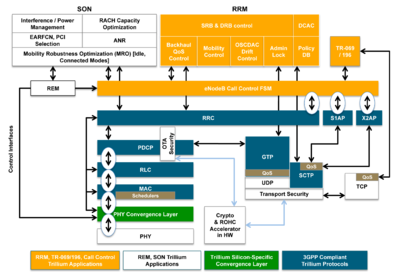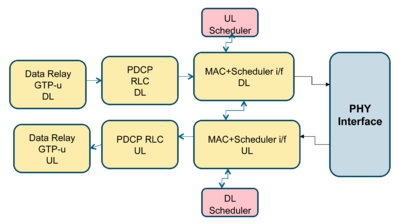Author: Renuka Bhalerao, Radisys company
High-speed mobile broadband traffic has exploded: mobile social networks have surged, and video will account for 70% of world traffic by 2016 (Source: Cisco Systems: Cisco Visual Networking Index: Global Mobile Data Traffic Forecast Update 2011-2016) . To keep up with demand, operators need to quickly and efficiently transition from 3G to LTE. Operators also seek to support heterogeneous networks (HetNets) consisting of macrocells, small cells, and cloud-based base stations to supplement their major networks. By using smaller cells, HetNets can increase each user's bandwidth and use cloud processing to reduce costs.
To support this new type of visual network architecture, communication equipment manufacturers (TEMs) need to provide operators with safe, high-performance, scalable and adaptable solutions to load changes and different device sizes. TEM meets these requirements through the use of the Intel® Communications Infrastructure Platform based on the Intel® Communications Chipset 89xx Family. This new platform enables the Intel® Architecture (IA) processor of many cores to match professional communication accelerators to create a unified communications architecture that can scale from < 1 Gbps to 80 Gbps. By combining this platform with Turnkey LTE eNodeB (eNB) software such as Radisys' Trillium TOTALeNodeB, TEM can significantly simplify the development process and quickly release a full range of solutions to the market.
Realize high-performance LTE network
Typically for data layer processing, TEMs use dedicated network processing units (NPUs), while IA is used for control layer signaling. Through the Intel® Communications Chipset 89 xx series, Intel provides a unified solution for control and data tiers, with even more savings in capital expenditures. As shown in Figure 1, the platform combines an extremely powerful and efficient IA core with encryption and data compression in the chipset, thereby alleviating the need for dedicated hardware such as security and packet processors. This unified platform satisfies the need for latency-constrained LTE data-layer packet processing, and has enough headroom to run signaling layer functions and add customer-related code for resource management algorithms or self-optimization capabilities.

(Click on image to enlarge)
Figure 1. The Intel® Communications Infrastructure Platform matches multi-core processors to the Intel® Communications Chip-Scale 89 xx Series. As shown, the platform is configured with the Intel® Xeon® processor e5 - 2600 series.
Moreover, the platform can be used in a variety of configurations to allow TEMs to quickly expand the design of various LTE devices. Settings from single-core processors to dual-socket 16 cores are optional for the processor. Similarly, chip sets can be used for multiple device configurations to provide additional acceleration where needed - a high-performance design of this kind is shown in Figure 1.
The Intel Communications Chipset 89 xx Series enhances the performance of the Intel® platform through QuickAssist technology, a new set of encryption and compression hardware accelerators that provide up to 20 Gbps of secure processing and 9 Gbps of data compression per device . The increase in performance makes the platform the best choice for Robust Header Compression (RoHC) and cryptographic functions required at the eNB. The Intel Communications Chipset 89xx series can offload encryption algorithms for SNOW3G, and can also offload KASUMI encryption/decryption for the air interface. In addition, it provides support for robust header compression and backhaul line security through IPSec. For more details on the chipset and the overall platform, please refer to "Technology Review: Intel® Communications Infrastructure Platform." )
Radisys's TOTALeNodeB software complements the Intel platform with a turnkey LTE solution that includes standards-compliant protocol implementations from L1 to L3, as well as professional features such as Radio Resource Management (RRM) and Self-Organizing Networks (SON). eNB application. (See Figure 2.) The software supports LTE Time Division Duplex (TDD) and Frequency Division Duplex (FDD) and an API that is well-defined and used to add client-specific MAC scheduler algorithms. This deployment-ready solution reduces integration time and allows TEMs to add value through customization and differentiation. The solution is optimized for multi-core IA processors and leverages the Intel Communications Chipset 89 xx series to accelerate network security and cryptographic capabilities, laying a solid foundation for high-performance LTE networks.

(Click on image to enlarge)
Figure 2. TOTALeNodeB from Radisys provides a complete L1 to L3 stack for LTE
Open programming model
Platforms based on the Intel Communication Chipset 89 xx series are all supported by communication software packages that simplify and accelerate design. This package includes the Intel® Data Layer Development Kit (Intel® DPDK), a set of source code programming libraries that optimize packet movement and processing on the IA. The Intel DPDK includes a data tier library, an optimized network interface card (NIC) driver that can efficiently manage queues and buffers, and a packet flow designed and optimized for IA. The Intel DPDK can perform bare-metal fast-path packet processing, which runs on multiple threads on the IA core, providing linear performance scaling (Figure 3).

Figure 3. The Intel® Data Layer Development Kit (Intel® DPDK) provides optimized packet processing performance.
Optimizing this low system overhead and running to completion environment is to achieve the fastest data layer performance, thereby providing additional efficiency for LTE user layer functional processing to tunnel GTPu data packets. For example, in the L3 packet forwarding, the two-chip platform realizes more than 160 million data packets per second, and the typical NPU is 100 million data packets per second. Customers can program data layer functions to implement Intel's eNBR based on DDK architecture, and can also run workloads such as local encryption or use hardware assistance on the companion chip.
Intel QuickAssist technology encryption and compression accelerators are accessed through a set of unified application programming interfaces (APIs). Radisys TOTALeNodeB supports these APIs while enabling TEM to utilize accelerators in a straightforward manner. TEM can also use accelerators through open source frameworks and applications using patches and shims. These programming options allow the TEM to create hardware that can migrate between different designs with minimal impact on the application. This capability is critical for this security solution, which is that it can scale from small cells to macro cells to cloud-based base stations for LTE.
Extend through software
The HetNet perspective of the network means that TEM must be able to expand the design to meet the requirements of different deployment scenarios from small cells to macrocells, and then integrate the platform architecture for different numbers of users. The TEM needs a method that has the advantage of faster and more efficient porting to ports on multi-core platforms, while meeting the LTE user layer's need for latency and performance, which is critical as far as scalability and performance are concerned. . With highly optimized and scalable software, the LTE eNB software architecture needs to withstand this challenge.
To enable ports to efficiently connect to multi-core platforms and multiple hardware threads, the combined hardware and software solutions can be extended using a traditional vertical model, which replicates instances of software on multiple cores for capacity. This solution also supports scaling through horizontal versions, where the real-time capabilities vital to the user layer are subdivided into finer-grained patterns to maximize the use of available cores. As shown in Figure 4, the eNB's L2 and L3 signaling message processing and application functions, such as RRM, can be scaled to run on up to 8 IA cores and leverage synchronous multithreading (SMT) in a Linux-based environment.

(Click on image to enlarge)
Figure 4. The Radisys Trillium LTE eNodeB utilizes multi-core Intel® Architecture (IA) technology.
Radisys's TOTALeNodeB can be easily partitioned to take full advantage of multi-core hardware architectures and support accelerators. A software partition with multiple instances can implement a high performance LTE user layer for macro eNBs. A good example of such software and hardware optimization is the Packet Data Convergence Protocol (PDCP) module portion of eNB L2. This PDCP module accesses the Intel Communication Chip 89 xx Series Accelerator via Intel QuickAssist technology to implement password and encryption functions. In addition, the architecture allows PDCP and Radio Link Control (RLC) to be separated into uplink and downlink blocks, enabling horizontal partitioning of software across independent cores (Figure 5).

Figure 5. The Radialsys TOTALeNodeB separates uplink (UL) and downlink (DL) processing.
Radisys's TOTALeNodeB software is easy to expand and can be tailored to support a wide range of deployments: from microcells to macrocells. Support for multiple software instances running independently on the platform core through load-balancing mode allows for greater flexibility and granularity of software partitions beyond vertical scaling, resulting in more expansion options and independent throughput performance. Using a scalable architecture that maps efficiently to available processing power, TOTALeNodeB is ready to face the challenges of Cloud Radio Access Network (C-RAN) and accommodate LTE base stations in a HetNet environment. This will enable TEM to quickly provide a full range of products for future networks to address a variety of wireless issues, including on-site acquisition, coverage and capacity expansion, and environmental management.
This complete solution with pre-integrated stacks for various eNB interfaces serves as a fixed framework and starting point, so TEM does not need to write code from scratch. These commercial off-the-shelf (COTS) stacks maintain their versatility through continuous development of standards (including the 3 GPP Rel 9 specification), thereby providing TEMs with compatible solutions for future deployment and end-to-end reference designs including eNBs, Evolved Core (EPC) UE simulator application. Radisys also provides expert services, so the entire integration can be done internally. Radisys can customize algorithms or develop new algorithms based on customer needs. The scope and effort involved depend on the needs of the customer.
A complete solution
Radisys and Intel offer a comprehensive software optimization and hardware acceleration solution using Radisys TOTALeNodeB protocol and application software integrated on platforms based on the Intel Communication Chipset 89 xx series. This solution can extend a wide range of LTE applications including small cells and C-RAN. With this complete solution, TEM can reduce development time and focus on customization to provide specific value-added products and services, thanks to all the necessary hardware and software components have been resolved.
Cixi Xinke Electronic Technology Co., Ltd. , https://www.cxxinke.com